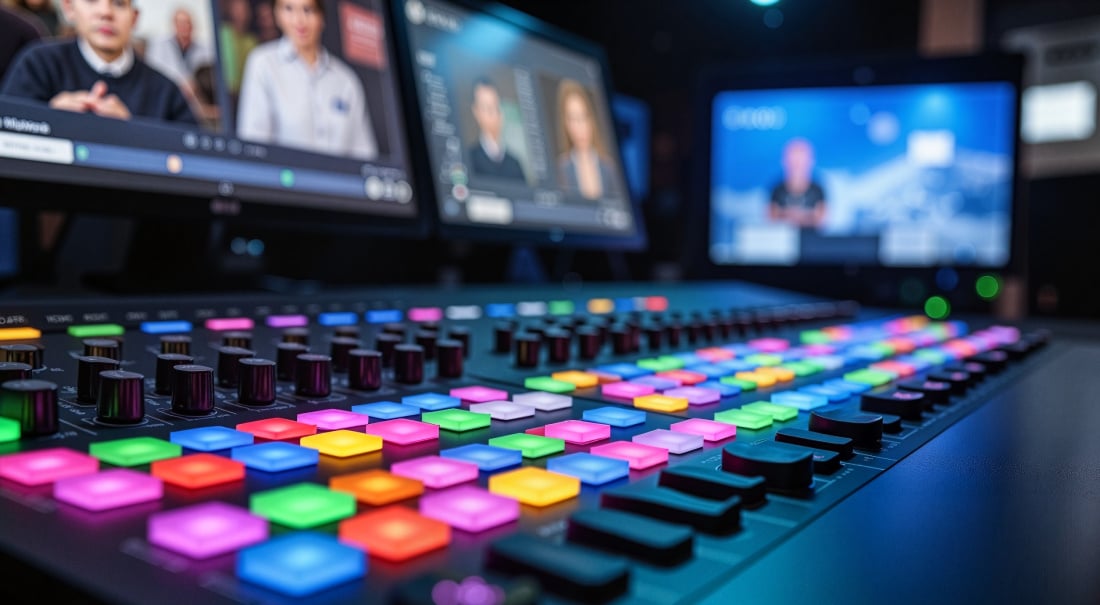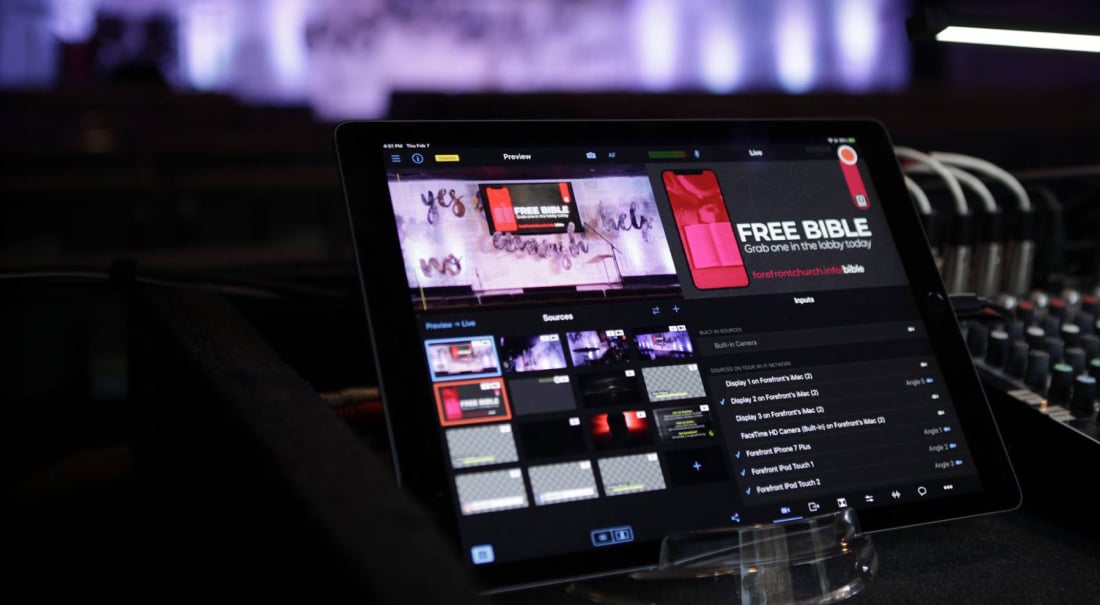
So you’ve hit that point where you’re asking, "What does a video switcher do?" Huzzah! Welcome to the club. While it may not be the most interesting topic at a dinner party, you’re in good company here.
Simply put, a video switcher allows you to manage and control multiple video sources in a live production setting, switching between different cameras, pre-recorded content, and graphics.
This is especially crucial for live events, live streaming, and broadcast TV, where seamless transitions are key. A video switcher is your best friend in the control room, and deciding between a hardware or software video solution is an important consideration.
Both hardware and software video switchers have their perks and pitfalls, and each tends to better suit different types of production environments. In this article, we’ll explore the pros and cons of both options and hopefully, by the end, you’ll have a better idea of which is the best choice for your production.

Hardware video switcher: the traditional powerhouse
Let’s start with the classic — the hardware video switcher.
This is the kind of switcher you probably picture when you imagine a live production setup. It's a physical piece of equipment that you plug your video sources into, and with the press of a button, you can switch between them.
Pros of hardware video switchers
Reliable performance
Hardware switchers are built for stability. They’re designed to handle heavy, continuous use without breaking a sweat. There's no worry about crashing or lag because the system is entirely dedicated to your video production tasks. Whether you're working with an ATEM Mini Pro or a top-tier broadcast switcher, these systems are trusted by professionals worldwide.

Easy to control
With tactile buttons and physical sliders, hardware switchers allow you to control video production in real time with precision. There’s no hunting through menus or waiting for things to load. The physical feel of the buttons can make live production switching a more intuitive and hands-on experience, especially in high-pressure environments.
Built-in inputs and outputs
Hardware video switchers often come with plenty of inputs and outputs right out of the box, ready to plug and play. If you’re dealing with multiple HDMI outputs, cameras, or other devices, you won’t need to fuss around with extra gear. The capture card integration is usually seamless as well, giving you a straightforward workflow.
Durability
Let’s face it — hardware feels sturdy. You don’t need to worry about overheating, lag, or software crashes that can sometimes occur with live video. When you’re relying on a hardware video switcher, you can feel confident that it’s built to last through any live production event.
Cons of hardware video switchers
Cost
Hardware video switchers are often more expensive than their software counterparts. A high-end switcher can cost thousands of dollars, and that’s not including any additional gear, like capture cards, video cameras, or cables. If you're working on a tight budget, this could be a huge factor to consider.
Limited flexibility
While hardware switchers are fantastic for live video, they tend to have limitations when it comes to flexibility. If you want to change the setup or add new features, you often need to buy additional equipment or upgrade the hardware. Plus, you’re typically stuck with what’s in front of you — no quick tweaks or updates.
Heavy setup
All that gear can become quite cumbersome, which is not so bad if you’re in a stationary studio environment. But if you need a portable solution or plan to move from venue to venue, this could be a hassle.
Software video switcher: the modern marvel
Now, let’s talk about the rising star of live production — the software video switcher.
This type of switcher operates entirely through your iOS device and uses software to handle video-switching tasks. In addition to Switcher, you might be familiar with streaming software like OBS Studio or vMix, both of which function as software video switchers. These tools have brought the power of live video switching to the masses in a more accessible and affordable way.
Pros of software video switchers

Cost-effective and accessible
Investing in traditional hardware switchers can be a major financial investment. This is where software video switchers come in to save the day. They leverage devices you already own (like your iPhone or a computer), so you don’t need to invest in expensive, dedicated equipment. This makes live streaming and video production accessible for those who may not have the budget for a full studio setup.
Additionally, instead of an upfront purchase, many software options (like Switcher) offer flexible pricing tiers, allowing you to scale up as you grow.
Portability
A major advantage of software video switchers is their portability. A software video switcher allows you to take your setup anywhere, especially if you have one you can download onto your phone. With Switcher, you can go live from anywhere with your iPhone, making it perfect for on-the-go creators, businesses, and event streamers.
Easy customization
You’re not stuck with physical limits when using software switchers. Many allow you to add or change features in just a few seconds.
With Switcher, you can add logos, lower thirds, graphics, text, and even pre-recorded video clips quickly and easily. Plus, with live editing, customizable layouts and split-screen options, you can make your live productions look polished and professional in no time at all. Having a customizable studio in your pocket certainly has its perks.

Versatility
One of the biggest advantages of software switchers? Their versatility. Unlike hardware switchers, software switchers aren’t limited by fixed settings. This makes them an ideal solution for a wide range of production needs.
No matter if you’re broadcasting a sports event or hosting a remote interview, software switchers can adapt to the way you work. If you’re using Switcher, you can switch between multiple angles, incorporate pre-recorded videos, and even bring in remote guests with just a few taps. Want to use professional video cameras in your stream? With the Accsoon SeeMo, you can connect almost any camera with an HDMI output to your iOS device for super crisp video. Not to mention, with direct integrations with platforms like Facebook and Twitch, you can instantly share your content.
Cons of software video switchers
System-dependent performance
While software switchers are incredibly versatile, they are entirely dependent on the performance of your device, whether it be an iPhone, iPad, or computer. If your system isn’t powerful enough, you could run into issues like lag, crashes, or delays during live production. Using a fully up-to-date device with a solid internet connection is essential for smooth operation.
Learning curve
Software video switchers may have a steeper learning curve compared to their hardware counterparts. With so many customizable settings, it can sometimes feel a bit overwhelming for newcomers. Knowing where to start, and leaning on your production community is a great way to ease those first-timer fears.
Reliability concerns
Unlike hardware video switchers that have a reputation for rock-solid reliability, software-based switchers are more prone to technical glitches. While most software solutions are stable, you do run the risk of encountering bugs or hiccups, particularly if you’re working with an unstable or outdated operating system.
Choosing the right switcher for your live streaming needs
Ultimately, whether you choose a hardware or software video switcher depends on your specific needs and production setup.
If you need a reliable, hands-on solution for a large-scale, professional production, a hardware video switcher may be the way to go. However, if you’re working with a smaller budget, need flexibility, or are on the move, a software video switcher can offer a fantastic, affordable alternative.
And if you’re considering a software video solution, here’s a link to try Switcher free for 14 days. Give it a test drive and see what you think!
Subscribe to the blog
Sign up to receive notifications whenever a new blog post is published. You may unsubscribe at any time.



